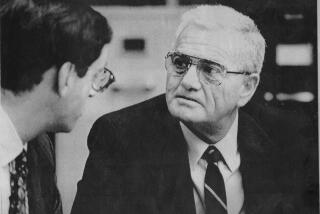Grim Sleeper suspect stayed below LAPD’s radar
- Share via
A backyard mechanic identified by police this week as the Grim Sleeper serial killer had a lengthy criminal history stretching over four decades but was never sent to prison despite calls by law enforcement officials for tough sentences, according to Los Angeles County court records released Friday.
Probation reports show that Lonnie David Franklin Jr. repeatedly cycled through the county’s justice system years before he was charged this week with killing 10 women in South Los Angeles.
Franklin was arrested at least 15 times for car theft, burglary, receiving stolen property, assaults, firearms possession and other crimes, the records show. In most cases, he avoided prosecution or was sent to jail and placed on probation even as law enforcement officers called him a serious criminal and urged prison terms.
Franklin allegedly killed seven women between 1985 and 1988, when his crimes seemed to abruptly stop, authorities say. The slayings resumed with three more between 2002 and 2007, police said.
In 2003, Los Angeles probation officers wrote that Franklin — then 50 — had admitted spending three decades as an active criminal and was back to his old ways when he was caught driving a luxury SUV stolen from the Glendale Galleria.
“If at this age the defendant is still engaging in criminal activities … the community can best be served by imposing the maximum time possible in state prison,” one probation officer wrote.
Franklin faced up to three years in prison after pleading no contest to receiving stolen property. As part of a plea agreement with prosecutors, however, he was sentenced to jail for 270 days.
Once he entered jail, Franklin again benefited from Los Angeles’ overburdened justice system. Sheriff’s officials were releasing inmates early to ease overcrowding in the county’s jails. Franklin was released in May 2003, more than four months early, according to jail data obtained by The Times.
Two months later, when he should still have been behind bars, Franklin allegedly killed again. In July 2003, a crossing guard in the Westmont area of the city stumbled across the lifeless body of Valerie McCorvey. The 35-year-old had suffered trauma to her neck, police said.
Franklin was only recently identified as a suspect in the case when a “familial search” of state DNA records indicated that a convicted felon was probably related to the killer. Franklin is the felon’s father.
Franklin’s attorney, Deputy Public Defender Regina A. Laughney, declined to comment, saying she had yet to review all of the evidence in the case.
Despite his numerous contacts with police, Franklin, now 57, was never entered into the state’s DNA database because his crimes were never considered serious enough. In 2004, voters approved a measure that required DNA be taken from every person convicted of a felony, but Franklin’s last conviction was a year earlier.
LAPD Det. Dennis Kilcoyne, who heads the LAPD task force investigating the killings, said he was not surprised by Franklin’s criminal record. Serial killers, he said, often turn out to have relatively low-level arrests that did not raise police suspicions.
“He’s a classic of what we’ve seen in the past,” Kilcoyne said. “He’s danced to the raindrops for a long time without getting wet.”
Franklin’s crimes, he said, did not involve the type of violence against women that would have drawn police interest at the time.
Probation reports offer more details about the man who neighbors said was known for helping the elderly with car trouble but also spoke about his visits to prostitutes.
Franklin told one probation officer that he graduated with a certification in welding after attending Los Angeles Trade Technical Community College for two years. He said he served in the U.S. Army from 1970 to 1976, earning an honorable discharge, records show.
Franklin was first arrested at the age of 16 on suspicion of car theft. He was arrested twice more as a juvenile, once for car theft and once for stealing property from a car, and was placed on probation, the reports said.
Police picked him up four more times between 1971 and 1984 on suspicion of theft, burglary and carrying a loaded firearm. The arrests resulted in only one misdemeanor conviction — for possessing a concealed weapon in 1974.
He was sentenced to 10 days in jail, according to court records.
During the height of the Grim Sleeper’s killings, between 1985 and 1988, Franklin avoided police attention. But the next year, he was arrested twice and was convicted of possessing burglary tools.
He was placed on probation.
Franklin found himself in regular trouble with the law during the 1990s, earning convictions for assault, battery and receiving stolen property.
In 1993, Los Angeles police officers caught him working on a stolen car in his backyard and found another stolen vehicle and several parts of more vehicles, including four engines, records said.
A probation report cited the lead police investigator as recommending that Franklin go to prison, describing him as “a major participant involved in auto theft” and saying he was suspected in the theft of at least 30 vehicles in a three-month period.
Nevertheless, the probation officer noted that Franklin had not been convicted of a felony until then and recommended he be sent to jail and placed on probation.
Franklin was sentenced to 365 days in jail.
Franklin’s criminal history has helped investigators piece together a picture of his movements, showing that he remained in Los Angeles even when the Grim Sleeper’s killings appeared to stop.
“It gives us some indication that he was at least in the neighborhood … during our dry spell,” Kilcoyne said, “which gives us more interest in rebuilding his life over the last 25 years in case there are more [victims] out there.”
Times data analyst Sandra Poindexter contributed to this report.
More to Read
Sign up for Essential California
The most important California stories and recommendations in your inbox every morning.
You may occasionally receive promotional content from the Los Angeles Times.












